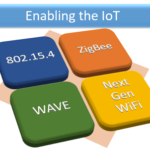IoT-enabling Technologies: IEEE 802.15.4, WLLN, ZigBee, WAVE, Next Gen WiFi
Eogogics IoT-enabling Technologies Workshop
The Internet is rapidly turning into a hyper-connected network of tens of billions of computers, smart phones, homes, buildings, vehicles, products, appliances, devices, machinery, and sensors. The Fifth Generation of Wireless (5G) is being engineered for such massive interconnectivity, but it will be aided by technologies such as LR-WPAN, WLLN, Zigbee, WAVE, and Next Gen WiFi.
The IEEE 802.15 working group is focused on the WPANs (Wireless Personal Area Networks). Its 802.15.4 standard specifies the MAC and physical layers that support low data rates with low power use. The 802.15.4 standard underlies most of the technologies used for home automation, smart utility networks, and industrial monitoring/control including ZigBee, WirelessHART, MIWi, Thread, SNAP, 6LoWPAN, Wi-SUN, and ISA100.11a. It’s therefore an important standard to study and the first one to be discussed in our IoT-Enabling Technologies Workshop.
Studied next in that course are the networks of low-power wireless devices that must operate effectively in lossy environments, e.g., M2M Communications and Smart City applications. We look at a wide variety of protocols including those used for connecting devices to the Internet (BLE, LR-WPAN, LoRaWAN), protocols that allow applications to run on these devices (ZigBee, Wi-SUN, WirelessHART, ISA100), and protocols that enable IP to work effectively in a lossy environment (6LoWLAN, RPL).
Part 3 of our IoT-Enabling Technologies Workshop focuses on Zigbee, a leading standard for connecting wireless sensors used in home, utility, and industrial environments. ZigBee Applications include controlling light switches, entertainment appliances, energy monitors, security equipment, patient monitoring, industrial control, and traffic management systems. Zigbee builds on the IEEE 802.15.4 Wireless Personal Area Network (WPAN) specification.
Regulators worldwide have allocated the upper 5 GHz band for the deployment of Intelligent Transport System (ITS) that will allow us to become better informed and coordinated, safer, and ‘smarter’ users of transport networks. Part 4 of the Eogogics IoT-Enabling Technologies Workshop discusses the IEEE 802.11p (WAVE) enhancements that enable a Wi-Fi radio to support communications between vehicles, or between vehicles and roadside units at vehicular speeds and at a greater range. In the US and Europe, 802.11p has been mandated at the lower MAC and physical layer. At the higher layers, the US integrated the IEEE 1609 specification, and Europe the ETSI EN 302 spec.
Last but not least, WiFi, the old workhorse for wireless local area networking in both the enterprise and home settings, is also evolving to meet the challenge of dense and ultra-dense IoT deployments. The Part 5 of our IoT-enabling Technologies Workshop studies 802.11ah Sub 1 GHz (HaLow), 802.11ax High Efficiency WLAN (HEW), 802.11ay Next Generation 60 GHz (NG60), and 802.11az Next Generation Position (NGP).
The Eogogics IoT-Enabling Technologies Workshop can be taught onsite at your offices or, in some cases, over the Web using our WebLive™ platform. It can be taught as a single 5-day course, scheduled in installments, or condensed to a shorter course focused on the technologies that interest you the most. When taught online, it is usually taught in half-day sessions to prevent participant burn-out. Various versions of this course, with and without lab work and taught at varying tech levels, are available to support the needs of audiences that include business planners and strategists, design engineers, test engineers, deployment and support professionals, operations personnel, network administrators, marketing/sales personnel, and others whose jobs require familiarity with the M2M/IoT technologies.
If your project requires a knowledge of any of the technologies discussed here, or a related technology for that matter, give us a call. We have high-powered instructors, typically with a PhD in wireless plus 25+ year engineering experience, teaching these courses for our clients.
Related articles: The Internet of Things (IoT) Revolution: Are You Ready? | The Internet of Things: Smart Devices, M2M, WSNs, and IoT | Technology and Society: AI, Robots, Drones, and People | Introduction: Power Up with Eogogics!


Sorry, comments for this entry are closed at this time.